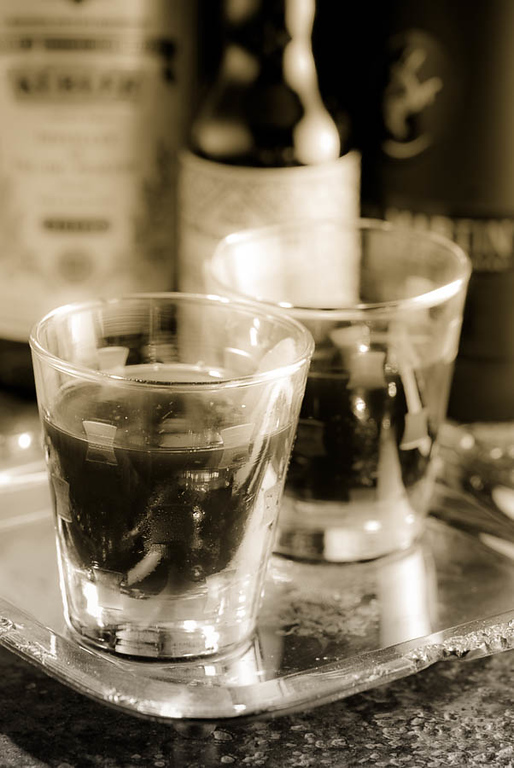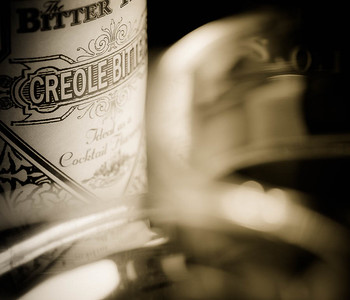The Sazerac has been one of my favorite cocktails for years, and its status as a “go-to” drink has become more entrenched as a wider selection of rye whiskies has come into my market, and especially as proper absinthe became available again.
But there is much more to the Sazerac than good whiskey and an absinthe wash. For starters, there’s cognac. And who knew that genever makes a great Sazerac?
Sazerac History
The cognac version evolved as a New Orleans variant of the “old-fashioned” Brandy Cocktail. There are conflicting stories woven into the Sazerac history, but on some points there is agreement. In 1850, a bartender named Sewell Taylor became the sole importer of a Cognac brandy made by Sazerac de Forge. Taylor sold his bar, the euphemistically named “Merchants Exchange Coffee House,” to Aaron Bird, who changed the name to “Sazerac Coffee House,” and promoted Taylor’s cognac with a house cocktail called the Sazerac Cocktail.

The record suggests that Bird’s Sazerac Cocktail wasn’t yet the Sazerac as we understand it today. It was a Cognac Old-Fashioned containing the local Peychaud’s bitters, manufactured only a couple blocks up the street from the Sazerac Coffee House. Absinthe, the hallmark of the modern Sazerac, was still missing from the written accounts of the properly made Sazerac.
But we do know that absinthe was gaining popularity as a cocktail additive during the 1860s. There is no record of absinthe being added specifically to the cognac-based Sazerac, but it isn’t much of a stretch to believe that the Sazerac Coffee House’s more fashionable clientele were experimenting with an absinthe rinse to modernize their cocktails. The Sazerac itself would not have been immune to updating; given its later history, it’s easy to believe that the Sazerac Cocktail could have picked up an absinthe wash, and evolved to fit the pattern of what Jerry Thomas recorded as “improved” cocktails.
But the end was near for the original Sazerac, with or without an absinthe rinse. When Thomas Handy took over the Sazerac Coffee House in 1869, brandy was disappearing from the American cocktail scene, increasingly hard to import due to the phylloxera epidemic that destroyed European grapevines. In 1873, Handy and the Sazarac abandoned cognac altogether. Rye whiskey, always popular and in plentiful supply in New Orleans, was the natural replacement. And absinthe, no longer an experimental ingredient, became a standard part of the formula. The cognac original disappeared from cocktail society, and the Sazerac became the rye whiskey drink we know today.
The Sazerac recipe
The original cognac version has had nearly 140 years to stage a comeback, but its only success so far seems to be in my kitchen. This is sad, because the cognac Sazerac is too good to forget. If you think you like the rye version, I recommend that you try the cognac version at least once. After all, we have plenty of cognac again.
The Improved Cognac Sazerac
- 2 oz Cognac (Remy-Martin VSOP, Landry VSOP, Ferrand Ambre)
- ¼–⅓ oz simple syrup (Demerara simple syrup)
- 4 dashes Peychaud’s bitters
- 1 dash Angostura bitters
- splash absinthe (Kubler)
- lemon garnish
Chill a rocks glass with crushed ice or ice water. In a second glass or mixing glass, combine sugar, bitters, and cognac; stir until chilled.
Empty the first glass and rinse with absinthe; pour off excess. Add ice if desired (ice is not traditional.) Strain the chilled cognac mix into the first glass. Express with lemon, and optionally add the lemon to the drink.
I’ve never used an expensive cognac for the Sazerac. While I don’t doubt that it would be a charming experience, I think a decent midrange VSOP is probably all you need to make a first-rate cocktail.
The simple syrup is a 1:1 simple. The cognac’s fruitiness compared to rye whiskey lets you cut back on the amount of sugar in the drink. For me, the quarter-ounce is ample.
 You can substitute Bitter Truth’s Aromatic and Creole bitters in this version. They have a softness that blends well with the lighter, fruitier nature of the brandy. There is a sweetness there, too, so there’s a delicate balance that you’ll have to find for whatever cognac you select.
You can substitute Bitter Truth’s Aromatic and Creole bitters in this version. They have a softness that blends well with the lighter, fruitier nature of the brandy. There is a sweetness there, too, so there’s a delicate balance that you’ll have to find for whatever cognac you select.
As I’ve said before, absinthe is far and away superior to the usual substitutes like Herbsaint or Pernod. As we used to say in college, “if you got it, flaunt it.” If not, Herbsaint makes a very respectable Sazerac.
So here’s the bottom line: at least half the time, I’m preferring the “old” cognac version, or even an aged genever version, to the “modern” rye-based Sazerac. And I’m interested to know this: do you prefer the rye version? The cognac version? Some other version? And why?
“Why is there cognac in my Sazerac?” at cold-glass.com : All text and photos Copyright © 2012 Douglas M. Ford. All rights reserved.

Great article!
I really enjoyed reading it.
Like you I prefer the Cognac version with a dash of sugar.
A bartender from Stuttgart (Germany) served me a Sazerac with equal parts Rye and Cognac.
I think that combination is also very interesting and a fun little twist to try from time to time.
Cheers.
Jonas
Sazeracs from Stuttgart, who knew? That cognac-rye combination is one you don’t come across very often. Dale DeGroff recommended a half-rye, half-cognac Sazerac in his 2002 Craft of the Cocktail. (When he published The Essential Cocktail six years later, he included both the half-and-half and the more standard all-whiskey formula.)
I’m glad you enjoyed the post!
I prefer the cognac version as well, and your recipe is an excellent one. Thanks for sharing it!
Thanks. It would be interesting to do a survey some time, cognac v. rye Sazeracs.
I greatly prefer the cognac version (something about my pallet doesn’t quite agree with absinthe and rye too often, and the sazerac was an exception until I tasted this version, and I can’t seem to go back)…a survey would be quite interesting!
Survey, yes, interesting idea. I’ve found that I quite enjoy the cognac version, too. Thanks!
After reading about the drink’s history, first on wikipedia, and then here, I tried making sazeracs with Remy VSOP and St George Absinthe last night. Without the punch of the rye, this version puts the absinthe and bitters front and center. If you enjoy those flavors, as I do, this is a fantastic variation (as it should be, for it is not a cheap drink).
Coincidentally, I just tried the same combination the other day; I agree, the absinthe and bitters definitely come forward more in the cognac version. Sazerac is such a versatile model to experiment with, and the Remy/St. George version is a keeper. Thanks for taking time to add your thoughts.
I knew cognac was original version. But wasn’t sure if ingredients added were same. Instead of simple syrup try using Amaretto, which is sweet. In France they have drink called FRENCH Connection of 1:1 or 2:1 cognac to amaretto. My son who lives there says choice of elite and gansters(? Really). Guess it’s like the Martini to our politicians. The sweetness is not overpowering. Nice cognac is D Usse about $45 bottle which gives good body to drink.
Another point. My daughter has mold makes large ice balls about tennis ball size. Pour absinthe over this, roll it around. When ready dump into glass 2 rook around and remove.
Helpful hint- corks from cognac bottles excellent stoppers for wine bottles since cognac grape product.
That’s very nice. I’m trying it with Perroquet absinthe and Akhtamar Armenian “cognac”.
I really enjoy a Sazerac made with Armagnac. It’s like the best of the cognac version and the best of the rye version together.
It would be amusing to stand the three options side-by-side and compare them directly.
As I remarked on the Rye and Absinthe page, I made one with Demarara rum (El Dorado 5 year), and it nicely balanced the absinthe substitute (Ricard). But I like strong flavors.
😊